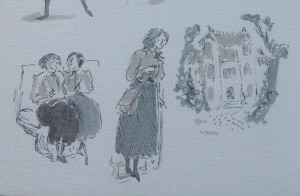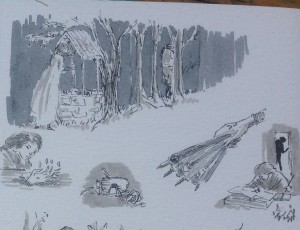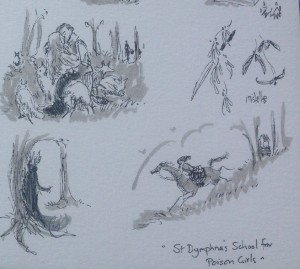
Art by Kathleen Jennings
The title for this story came from a friend’s throwaway line about St Dymphna’s Home for the Wealthy Insane (thanks, Dr Carson). I thought “No, St Dymphna’s Home for Poison Girls” and my mind went off on its own and sat in a corner, conjuring visions of a boarding school like the one in Charlotte Brontë’s Villette except with more murder and fewer French lessons.
I thought about finishing schools for young ladies and the sorts of girls who are sent there, and the kinds of families they come from. I thought about the strife between grand houses caused by matters of pride and honour (not to mention thefts), and wondered what might happen if the female offspring from those grand houses might be taught something useful … which was still misused by said houses. I wondered about the sorts of young women who might not think beyond what their families were sending them to do, who didn’t say to themselves “Sod this for a game of soldiers – I’ve just been taught these great and terrible skills by independent and terrifying women, why should I go off to die in the service of my family? Why shouldn’t I too become an independent and terrifying woman?”
Which is precisely the sort of thing Mercia does think for she’s not one of the herd, although in the end she follows a different path as well. And she’s also been sent off to do something dangerous by her surrogate family, the Little Sisters of St Florian, so in some ways she’s also a pawn but smart enough to break away. Mercia is the youngest daughter of Wulfwyn from “The Burnt Moon”, and the youngest sister of Delling, who frees the ghosts of Southarp in “The Undone and the Divine”. She appears again in the new collection The Tallow-Wife and Other Tales. This story first appeared in The Review of Australian Fiction, Volume 9, Issue 3 – and is shortlisted for Best Fantasy Short Story at this year’s Aurealis Awards.

Art by Kathleen Jennings
St Dymphna’s School for Poison Girls
‘They say Lady Isabella Carew, née Abingdon, was married for twenty-two years before she took her revenge,’ breathes Serafine. Ever since we were collected, she, Adia and Veronica have been trading stories of those who went before us – the closer we get to our destination, the faster they come.
Veronica takes up the thread. ‘It’s true! She murdered her own son – her only child! – on the eve of his twenty-first birthday, to wipe out the line and avenge a two-hundred year old slight by the Carews to the Abingdons.’
Adia continues, ‘She went to the gallows, head held high, spirit unbowed, for she had done her duty by her family, and her name.’
 On this long carriage journey I have heard many such recountings, of matrimony and murder, and filed them away for recording later on when I am alone, for they will greatly enrich the Books of Lives at the Citadel. The Countess of Malden who poisoned all forty-seven of her in-laws at a single banquet. The Dowager of Rosebery, who burned the ancestral home of her enemies to the ground, before jumping from the sea cliffs rather than submit to trial by her lessers. The Marquise of Angel Down, who lured her father-in-law to one of the castle dungeons and locked him in, leaving him to starve to death – when he was finally found, he’d chewed on his own arm, the teeth marks dreadful to behold. Such have been the bedtime tales of my companions’ lives; their heroines affix heads to the ground with spikes, serve tainted broth to children, move quietly among their marriage-kin, waiting for the right moment to strike. I have no such anecdotes to tell.
On this long carriage journey I have heard many such recountings, of matrimony and murder, and filed them away for recording later on when I am alone, for they will greatly enrich the Books of Lives at the Citadel. The Countess of Malden who poisoned all forty-seven of her in-laws at a single banquet. The Dowager of Rosebery, who burned the ancestral home of her enemies to the ground, before jumping from the sea cliffs rather than submit to trial by her lessers. The Marquise of Angel Down, who lured her father-in-law to one of the castle dungeons and locked him in, leaving him to starve to death – when he was finally found, he’d chewed on his own arm, the teeth marks dreadful to behold. Such have been the bedtime tales of my companions’ lives; their heroines affix heads to the ground with spikes, serve tainted broth to children, move quietly among their marriage-kin, waiting for the right moment to strike. I have no such anecdotes to tell.
The carriage slows as we pass through Alder’s Well, which is small and neat, perhaps thirty houses of varied size, pomp, and prosperity. None is a hovel. It seems life for even the lowest on the social rung here is not mean – that St Dymphna’s, a fine finishing school for young ladies as far as the world-at-large is concerned, has brought prosperity. There is a pretty wooden church with gravestones dotting its yard, two or three respectable mausoleums, and all surrounded by a moss-encrusted stone wall. Smoke from the smithy’s forge floats against the late afternoon sky. There is a market square and I can divine shingles outside shops: a butcher, a baker, a seamstress, an apothecary. Next we rumble past an ostlery, which seems to bustle, then a tiny school house bereft of children at this hour. So much to take in but I know I miss most of the details for I am tired. The coachman whips up the horses now we are through the hamlet.
 I’m about to lean back against the uncomfortable leather seat when I catch sight of it – the well for which the place is named. I should think more on it, for it’s the thing, the thing connected to my true purpose, but I am distracted by the tree beside it: I think I see a man. He stands, cruciform, against the alder trunk, arms stretched along branches, held in place with vines, which may be mistletoe. Green barbs and braces and ropes, not just holding him upright, but breaching his flesh, moving through his skin, making merry with his limbs, melding with muscles and veins. His head is cocked to one side, eyes closed, then open, then closed again. I blink and all is gone, there is just the tree alone, strangled by devil’s fuge.
I’m about to lean back against the uncomfortable leather seat when I catch sight of it – the well for which the place is named. I should think more on it, for it’s the thing, the thing connected to my true purpose, but I am distracted by the tree beside it: I think I see a man. He stands, cruciform, against the alder trunk, arms stretched along branches, held in place with vines, which may be mistletoe. Green barbs and braces and ropes, not just holding him upright, but breaching his flesh, moving through his skin, making merry with his limbs, melding with muscles and veins. His head is cocked to one side, eyes closed, then open, then closed again. I blink and all is gone, there is just the tree alone, strangled by devil’s fuge.
My comrades have taken no notice of our surrounds, but continue to chatter amongst themselves. Adia and Serafine worry at the pintucks of their grey blouses, rearrange the folds of their long charcoal skirts, check that their buttoned black boots are polished to a high shine. Sweet-faced Veronica turns to me and reties the thin forest green ribbon encircling my collar, trying to make it sit flat, trying to make it neat and perfect. But, with our acquaintance so short, she cannot yet know that I defy tidiness: a freshly pressed shirt, skirt or dress coming near me will develop wrinkles in the blink of an eye; a clean apron will attract smudges and stains as soon as it is tied about my waist; a shoe, having barely touched my foot, will scuff itself and a beribboned sandal will snap its straps as soon as look at me. My hair is a mass of – well, not even curls, but waves, awkward, thick, choppy, rebellious waves of deepest fox-red that will consent to brushing once a week and no more, lest it turn into a halo of frizz. I suspect it never really recovered from being shaved off for the weaving of Mother’s shroud; I seem to recall before then it was quite tame, quite straight. And, despite my best efforts, beneath my nails can still be seen the half-moons of indigo ink I mixed for the marginalia Mater Friðuswith needed done before I left. It will fade, but slowly.
The carriage gives a bump and a thump as it pulls off the packed earth of the main road and takes to a trail barely discernable through over-long grass. It almost interrupts Adia in her telling of the new bride who, so anxious to be done with her duty, plunged one of her pearl-tipped, steel-reinforced veil-pins into her new husband’s heart before ‘Volo’ had barely left his lips. The wheels might protest at water-filled ruts, large stones and the like in their path, but the driver knows this thoroughfare well despite its camouflage; he directs the nimble horses to swerve so they avoid any obstacles. On both sides, the trees rushing past are many and dense. It is seems a painfully long time before the house shows itself as we take the curved drive at increased speed, as if the coachman is determined to tip us all out as soon as possible and get himself back home to Alder’s Well.
***

